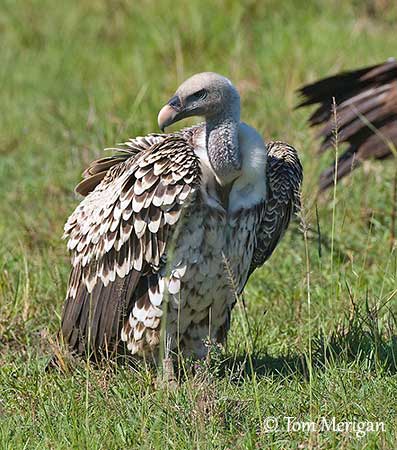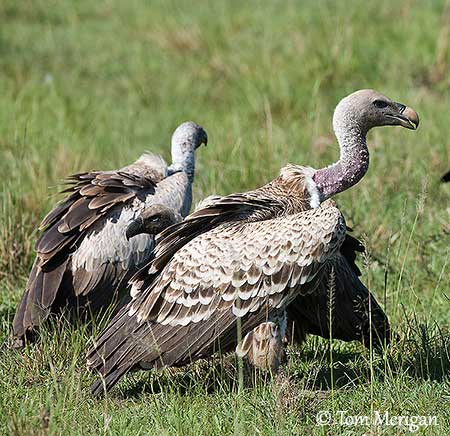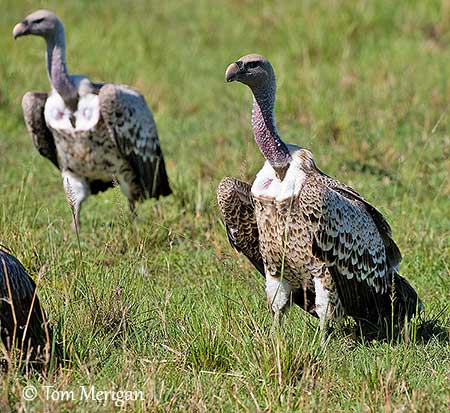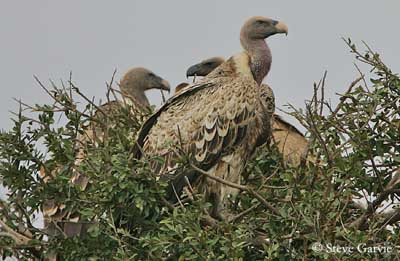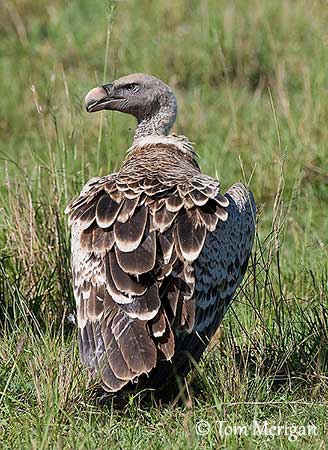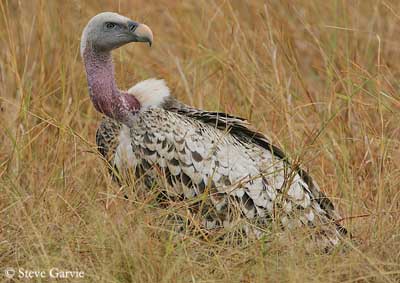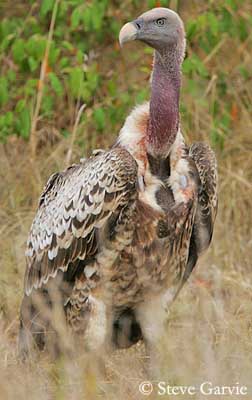
Ruppell's Griffon
Gyps rueppellii
Accipitriforme Order – Accipitridae Family
BIOMETRICS:
Length: 85-95 cm
Wingspan: 220-240 cm
Weight: 7500g
DESCRIPTION:
Ruppell’s Griffon has black plumage with numerous pale buff edges, mainly on the underparts. The wing pattern is very distinctive with conspicuous bar and two lines of white spots crossing the flight feathers.
The tail is darker and rounded.
Head and neck are covered with short whitish feathers. The skin may become purple when the bird is excited. The neck shows whitish ruff at the base. The bill is dull yellow and grey. It is very sharp, and used for tearing up skin and flesh from carcasses. Strong legs and feet are slate-grey. Eyes are yellow to amber.
Fr: Vautour de Rüppell
All : Sperbergeier
Esp : Buitre Moteado
Ital : Grifone di Rueppell
Nd : Rüppellgier
Russe : Гриф Рюппеля
Sd: Rüppellgam
Photographers:
Steve Garvie
RAINBIRDER Photo galleries & Flickr Rainbirder
Tom Merigan
Tom Merigan’s Photo Galleries
Text by Nicole Bouglouan
Sources :
HANDBOOK OF THE BIRDS OF THE WORLD Vol 2 by Josep del Hoyo-Andrew Elliot-Jordi Sargatal - Lynx Edicions - ISBN: 8487334156
BIRDS OF AFRICA SOUTH OF THE SAHARA by Ian Sinclair and Peter Ryan - Princeton University Press Princeton and Oxford - ISBN: 0691118159
BIRDS OF PREY OF AFRICA AND ITS ISLANDS by Alan and Meg Kemp - Struik Publishers - ISBN: 1770073698
GUIDE DES RAPACES DIURNES – Europe, Afrique du Nord et Moyen-Orient de Benny Génsbol – Delachaux et Niestlé – ISBN : 2603013270
Wikipedia (Wikipedia, The Free Encyclopedia)
Other article: The Old World Vultures
The juvenile is darker with reddish-brown back and wings, and lacks the adult’s scaled pattern. Flight feathers are blackish. The bill is black. Head and neck are reddish-pink and covered with brown down.
We find two subspecies: G.r. rueppellii and G.r. erlangeri, which share the range.
Ruppell’s Griffons belong to the Old World Vultures, in order to distinguish them from Condors.
VOICE: SOUNDS BY XENO-CANTO
Ruppell’s Griffon is usually silent, but near carcasses, it gives calls and rasping peeping. It also may whistle and cackle when perched.
Young utter weak whistles before to call.
HABITAT:
Ruppell’s Griffon frequents hillsides and mountains, open and arid areas, savannahs and grasslands.
RANGE:
Ruppell’s Griffon is found from Senegal to northern Nigeria, Sudan, western Ethiopia, Uganda, Kenya and northern Tanzania.
BEHAVIOUR:
Ruppell’s Griffon is very gregarious. It prefers to roost, feed and nest in colonies of up to 1000 pairs.
It is usually dominant at carcasses, except in front of the Lappet-faced Vulture which is larger than him. It is a scavenger, and does not need to find supplementary living preys. It only depends on large carcasses detected thanks to the keen sight and probably its smell.
It may fly over great distances, up to 150 km, from the nest to a carcass. Once some vultures are around the carcass, the others pounce on them to take part in the feast. They are able to eat an antelope in about 20 minutes.
Ruppell’s Griffon spends long time using the thermals currents, soaring and circling above the plains, searching for food. As soon as a carcass is detected, they fly down, always circling, more and more at low height, and at the end, pouncing on the food while they give raucous calls and squabbling. Their strong bill is used for tearing up the flesh, and the long bare neck can dig about into the carcasses. After feeding, they digest perched in the sun.
They roost in colonies on inaccessible cliffs at night, perching about one hour before sunset. Some hours before sunrise, they rush forwards in the air.
The courtship displays show the pair soaring and circling close to the cliffs. Both mates remain perched together during long time.
FLIGHT:
When soaring, the Ruppell’s Griffon holds the wings flattened or slightly raised. It is able to soar at about 11 000 metres height. It may soar during 6 to 7 hours per day when searching for carcass.
When it takes off, it is able to fly over 5 km in 6 minutes. It may travel up to 150 km in the day for feeding.
REPRODUCTION:
Breeding season varies according to the range.
The Ruppell’s Griffon nests on cliffs, in colonies of up to 1000 pairs.
Nest is bulky, made with sticks and lined with grass and leaves. It is situated on ledge. The female often steals some sticks in other nests, and the male arranges them in the nest.
According to the place, the nest may be reused year after year, or not. In some parts of the range, such as northern Cameroon, this species nests in trees.

Female lays one egg after a long rainy season. Incubation lasts about 55 days, by both parents. They feed and care the young together. The chick is covered in grey down.
The adults lose weight during the nesting period, but they can afford to do without food. As soon as the young fledge, at about 12 weeks of age, they can recover their weight little by little.
DIET:
Ruppell’s Griffon feeds on carrion and carcasses detected thanks to its keen sight.
PROTECTION/THREATS/STATUS:
The Ruppell’s Griffons play an important scavenger role because they clear nature of dead animals. They only predators are carnivorous.
Some decline occurred in Kenya, due to pesticides and habitat loss for agriculture increase.
